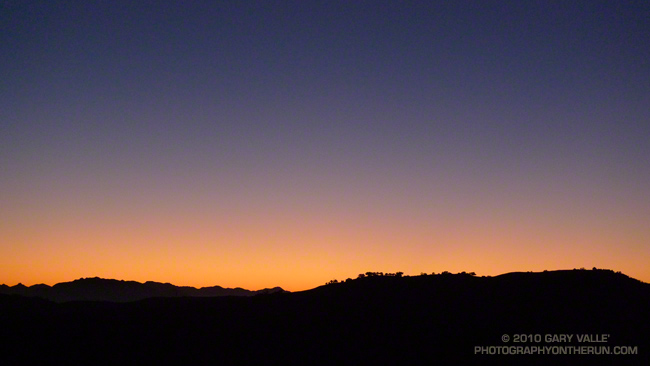
Coast live oaks along the Simi Peak Trail at China Flat. From Sunday’s run to Simi Peak.

Coast live oaks along the Simi Peak Trail at China Flat. From Sunday’s run to Simi Peak.

From a short run at Paramount Ranch last Saturday after climbing Ladyface.

For an eighty degree day, it had been surprisingly cold in Las Virgenes Canyon. The canyon’s east-facing slopes had been in shadow for much of the afternoon, and had lost any residual warmth to a crystal clear sky. The refrigerated air had spilled from the hillsides, collected in low points, and flowed in a frigid stream down the canyon.
In running shorts and a t-shirt, the cold air had been invigorating, but in the fading light I was glad to be out of the canyon, and running up the Beast toward Lasky Mesa.

The sun had set about 30 minutes before. Unmarked by clouds or contrails, the colors of the western sky were remarkably pure, ranging from the warm yellow-orange of a fleeting day to the cold steel blue of approaching night.
The sweet licorice scent of fennel swept past on a warm current of air. Along the trail crickets called, buoyant and hopeful; and a covey of quail chattered anxiously, debating flight. Above, the moon and Jupiter shone brightly, already beginning to illuminate the landscape.
On a hill to my right a solitary coyote yipped, and a nearby hillside answered in an excited sing-song of yips, yaps and yowls. Moments later another band answered the first, and then faraway a third.
Early in the run I had pushed the pace hoping to beat the sun back to car. Somewhere on the north boundary ridge it had become clear that I would lose the race with the sun. But I also realized it would not be a problem. There was no rush. I could catch the moon.

It’s unusual to see this much green in Southern California in mid November. The growth is the result of a wet October, with some areas recording several times the normal amount of rainfall.
Although water year rainfall totals for many areas of Southern California are still near or above normal for the date, November is the customary start of the rain season, and so far this month, we’ve been drier than normal.
That might change this weekend. Models have been having a tough time with the evolution of a low and trough that is already producing rain and snow in the Pacific Northwest. In true La Nina fashion, the high amplitude flow might result in the southern part of the trough being more offshore (wetter), or more onshore (drier), as it sets up over the West. We’ll see!
The photograph is from this afternoon’s run in the Simi Hills.

Sprawling oaks along the Blue Canyon Trail.
From this morning’s run of a variation of the XTERRA Boney Mountain Trail Run course.

The cirrus clouds were a couple of days ahead of a cold front that brought rain to much of Southern California.
From a trail run on October 27th that looped through Las Virgenes Canyon.